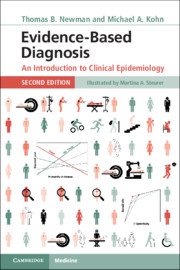Book contents
- Evidence-Based Diagnosis
- Evidence-Based Diagnosis
- Copyright page
- Dedication
- Contents
- Preface
- Acknowledgments
- Chapter 1 Introduction
- Chapter 2 Dichotomous Tests
- Chapter 3 Multilevel and Continuous Tests
- Chapter 4 Critical Appraisal of Studies of Diagnostic Test Accuracy
- Chapter 5 Reliability and Measurement Error
- Chapter 6 Risk Predictions
- Chapter 7 Multiple Tests and Multivariable Risk Models
- Chapter 8 Quantifying Treatment Effects Using Randomized Trials
- Chapter 9 Alternatives to Randomized Trials for Estimating Treatment Effects
- Chapter 10 Screening Tests
- Chapter 11 Understanding P-Values and Confidence Intervals
- Chapter 12 Challenges for Evidence-Based Diagnosis
- Answers to Problems
- Index
- References
Chapter 10 - Screening Tests
Published online by Cambridge University Press: 02 May 2020
- Evidence-Based Diagnosis
- Evidence-Based Diagnosis
- Copyright page
- Dedication
- Contents
- Preface
- Acknowledgments
- Chapter 1 Introduction
- Chapter 2 Dichotomous Tests
- Chapter 3 Multilevel and Continuous Tests
- Chapter 4 Critical Appraisal of Studies of Diagnostic Test Accuracy
- Chapter 5 Reliability and Measurement Error
- Chapter 6 Risk Predictions
- Chapter 7 Multiple Tests and Multivariable Risk Models
- Chapter 8 Quantifying Treatment Effects Using Randomized Trials
- Chapter 9 Alternatives to Randomized Trials for Estimating Treatment Effects
- Chapter 10 Screening Tests
- Chapter 11 Understanding P-Values and Confidence Intervals
- Chapter 12 Challenges for Evidence-Based Diagnosis
- Answers to Problems
- Index
- References
Summary
While screening tests share some features with diagnostic tests, they deserve a chapter of their own because of important differences. Whereas we generally do diagnostic tests on sick people to determine the cause of their symptoms, we generally do screening tests on healthy people with a low prior probability of disease. The problems of false positives and harms of treatment loom larger. In Chapter 4, on evaluating studies of diagnostic test accuracy, we assumed that accurate diagnosis would lead to better outcomes. The benefits and harms of screening tests are so closely tied to the associated treatments that it is hard to evaluate diagnosis and treatment separately. Instead, we compare outcomes such as mortality between those who receive the screening test and those who don’t. We postponed our discussion of screening until after our discussion of randomized trials because randomized trials are a key element in the evaluation of screening tests. Finally, because decisions about screening are often made at the population level, political and other nonmedical factors are more influential. Thus, in this chapter, we focus explicitly on the question of whether doing a screening test improves health, not just on how it alters disease probabilities, and we pay particular attention to biases and nonmedical factors that can lead to excessive screening.1
- Type
- Chapter
- Information
- Evidence-Based DiagnosisAn Introduction to Clinical Epidemiology, pp. 250 - 279Publisher: Cambridge University PressPrint publication year: 2020



